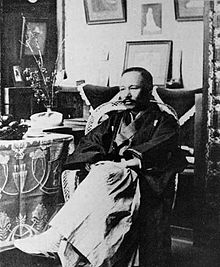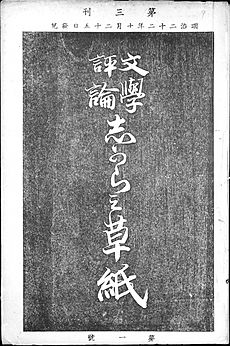Mori Ōgai facts for kids
Quick facts for kids
Mori Ōgai
Senior Second Rank
|
|
|---|---|

Mori Ōgai in 1911
|
|
| Native name |
森 鷗外
|
| Born | February 17, 1862 Tsuwano, Shimane, Japan |
| Died | July 8, 1922 (aged 60) Tokyo, Japan |
| Allegiance | |
| Service/ |
|
| Years of service | 1882–1916 |
| Rank | Surgeon General of the Imperial Japanese Army (Lieutenant General) |
| Battles/wars | |
| Awards | Grand Cordon of the Order of the Rising Sun Grand Cordon of the Order of the Sacred Treasure Order of the Golden Kite, 3rd Class |
| Relations | Mari Mori (daughter) |
| Other work | Translator, novelist, and poet |
Lieutenant-General Mori Rintarō (森 林太郎, February 17, 1862 – July 8, 1922), known by his pen name Mori Ōgai (森 鷗外), was a very important Japanese figure. He was a high-ranking army doctor, a talented translator, a novelist, and a poet. He was also the father of the famous writer Mari Mori.
Mori Ōgai earned his medical license at a very young age. He helped introduce German books and ideas to Japan. He was also one of the first to successfully write Western-style poetry in Japanese. He created many writing styles and wrote many works. His novel The Wild Geese (1911–1913) is considered his most famous work. After he passed away, he was seen as one of the main writers who helped modernize Japanese literature.
Contents
Mori Ōgai's Life Story
Early Years and Education
Mori Rintarō was born in Tsuwano, a town in Japan. His family had been doctors for the local lord, called a daimyō, for many generations. Since he was the oldest son, everyone expected him to become a doctor too.
He went to school to study Confucian classics, which were ancient Chinese teachings. He also took private lessons in rangaku, which meant "Western learning." This included learning the Dutch language.
In 1872, his family moved to Tokyo. Mori lived with Nishi Amane, who taught him German. German was the main language for medical studies back then. In 1874, he joined a government medical school. He graduated in 1881 at just 19 years old. He was the youngest person in Japan to get a medical license. During this time, he also became very interested in literature and read many popular novels.
Starting His Career
After finishing school, Mori joined the Imperial Japanese Army as a medical officer. He wanted to focus on military medicine and health. In 1882, he became a deputy surgeon, similar to a lieutenant.
From 1884 to 1888, the Army sent Mori to study in Germany. He visited cities like Leipzig, Dresden, Munich, and Berlin. While there, he also became very interested in European literature. Fun fact: Mori Ōgai was the first Japanese person known to have ridden on the famous Orient Express train! He learned a lot about European culture, which helped him create new writing styles in Japan.
While in Germany, Mori Ōgai showed his strong love for Japan. Once, he debated a German geologist, Dr. Edmund Naumann. Dr. Naumann had criticized Japan in a public talk. Mori Ōgai spoke up to defend his home country. He argued that Japan's modernization was a natural and smart choice. He believed it was important for Japan to learn from the West but also keep its own traditions.
After four years in Germany, Mori felt it was his job to help Japanese people think in new ways. He wanted to introduce Western scientific methods to Japan. He wrote articles and joined debates to share his ideas. He believed Japan needed to understand the scientific method, not just copy Western inventions. This way, Japan could create its own new science in the future.
Mori Ōgai also worried that too much Western influence could harm Japanese traditions. He thought Japanese culture was special and valuable. For example, in his essay Nihon Kaoku ron, he said that city planning should be based on science, not just on copying Western styles. Because of his ideas, he became known as a public educator.
When he returned to Japan, he was promoted in the Army. He became a high-ranking army doctor. He pushed for more scientific medical research and even started his own medical journal. He also worked to improve modern Japanese literature. He published his own literary journal, Shigarami sōshi, and a book of poetry, Omokage. In his writings, he focused on emotions and spiritual ideas, rather than just everyday reality. His short story "The Dancing Girl" (1890) was about a Japanese man and a German woman.
Mori Ōgai was married twice. His first wife was Toshiko Akamatsu, and they had a son named Oto. They divorced in the same year they married. Later, in 1902, he married Shigeko Arakawa. They had four children: Mari, Furitsu, Annu, and Rui. His daughters, Mari and Annu, and his son Rui, all became writers.
Later Career and Literary Work
At the start of the First Sino-Japanese War (1894–1895), Mori was sent to Manchuria and then to Taiwan. In 1899, he became the head of the Army Medical Corps. He was based in Kokura, a city in Japan. He was later moved to Tokyo in 1902. During the Russo-Japanese War (1904–05), he was part of a division based in Hiroshima.
In 1907, Mori was promoted to Surgeon General of the Army. This was the highest medical position in the Japanese Army. He also became the head of the Imperial Fine Arts Academy. In the same year, he led research into Beriberi, a serious disease. Mori Ōgai helped find the cause of beriberi, but a full cure was found only after his death.
He retired in 1916 and became the director of the Imperial Museum. Mori Ōgai passed away six years later, at age 60, from kidney failure and tuberculosis.
His Writings and Ideas
Even though Mori Ōgai didn't write much from 1892 to 1902, he continued to edit a literary journal. He also translated works by famous European writers like Goethe, Schiller, and Hans Christian Andersen. During the Russo-Japanese War, he started keeping a poetry diary. After the war, he held tanka (a type of Japanese poetry) writing parties with other poets. In 1909, he helped start a new magazine called Subaru (literary magazine).
His later works can be divided into three periods. From 1909 to 1912, he wrote stories based on his own life. This period includes his most famous novel, Gan (雁, The Wild Geese, 1911–13). This story is set in Tokyo in 1881 and was made into a movie in 1953.
Ōgai also wrote about problems in the art and literature world of his time. He was worried about intellectual freedom after the High Treason Incident in 1910. In this event, some people were wrongly accused and executed. Even though he worked for the government, Ōgai spoke out for freedom of speech and thought.
From 1912 to 1916, his writing changed from fiction to historical stories. He was deeply affected by the death of General Nogi Maresukea, a Japanese Army general. Ōgai began to explore Japanese history and the reasons behind old traditions. He wrote biographies of historical figures, like ‘Abe Ichizoku’ and ‘Shibue Chusai’. Through these stories, he showed how people in the past were sometimes victims of old customs.
One of Ōgai’s earlier works, Dancing Girl (舞姫), tells the story of a Japanese student, Toyotarō, who falls in love with a German woman named Elis. He faces a tough choice between his new life in Germany and his duties back in Japan. This story shows the conflict between traditional Japanese values and the new ideas coming from the West during the Meiji Restoration.
Ōgai also rewrote an old Japanese story called Sansho Dayu. He changed some small details and the ending to make it more appealing to a wider audience. He also removed some magical parts from the original. His version of Sansho Dayu was made into a movie in 1954.
Mori Ōgai's Impact

Mori Ōgai is considered one of the most important writers of the Meiji period in Japan. In his literary journals, he helped start modern literary criticism in Japan. This means he helped people learn how to analyze and understand literature in new ways.
The house where Mori Ōgai lived in Kokurakita Ward in Kitakyūshū is now preserved. He wrote his "Kokura Diary" there. His birth home in Tsuwano is also preserved. Both houses are similar in their traditional Japanese style.
Because of his biographies, especially Shibui Chusai (1916), Ōgai is known as a pioneer of modern biographical literature in Japan.
His daughter, Mari, who was 19 when he died, wrote a lot about her relationship with her father. Her stories influenced the creation of the Yaoi genre, which are stories about male-male relationships written by women for women.
Honours and Awards
Mori Ōgai received many important awards and ranks during his life:
- Order of the Golden Kite, 3rd Class (1906)
- Grand Cordon of the Order of the Sacred Treasure (1915)
- Grand Cordon of the Order of the Rising Sun (1915)
He also received several court ranks, showing his high standing in Japanese society. His highest rank was Senior Second Rank, given to him after his death.
Selected Works
- Maihime (舞姫, The Dancing Girl (1890))
- Utakata no ki (うたかたの記, Foam on the Waves (1890))
- Fumizukai (文づかひ, The Courier (1891))
- Seinen (青年, Young Men (1910))
- Gan (雁, The Wild Geese (1911–13))
- Okitsu Yagoemon no isho (興津弥五右衛門の遺書, The Last Testament of Okitsu Yagoemon (1912))
- Sanshō Dayū (山椒大夫, Sanshō the Steward (1915))
- Takasebune (高瀬舟, The Boat on the Takase River (1916))
- Shibue Chūsai (渋江抽斎, Shibue Chusai (1916))
- Izawa Ranken (伊澤蘭軒, Izawa Ranken (1916–17))
- Hojo Katei (北条霞亭, Hojo Katei (1917–18))
Movies Based on His Works
Several of Mori Ōgai's stories have been made into movies:
- The Abe Clan (1938)
- The Wild Geese (1953)
- Sansho the Bailiff (1954) – This movie is based on his short story and is considered a very important Japanese film.
- The Abe Clan (1995)
Images for kids
See also
 In Spanish: Mori Ōgai para niños
In Spanish: Mori Ōgai para niños
- Kokura
- Takasebune






